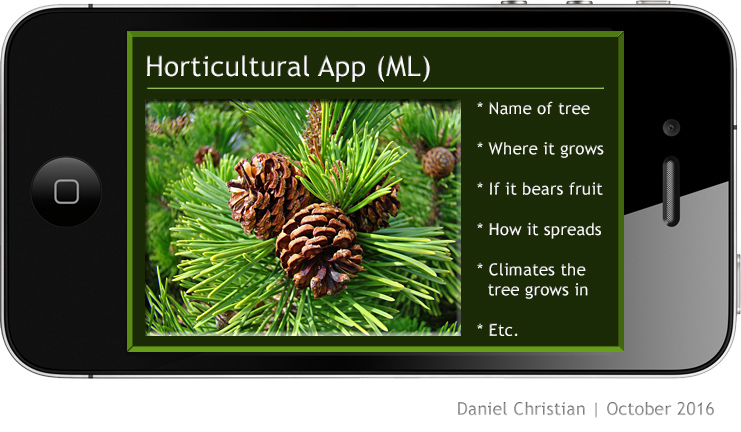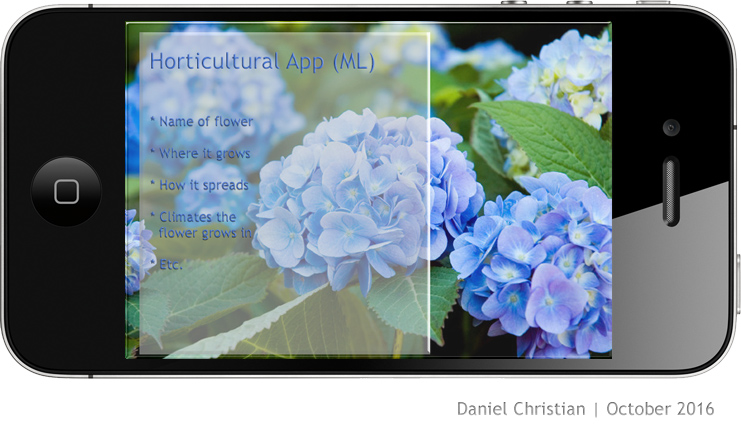From DSC:
Consider the affordances that we will soon be experiencing when we combine machine learning — whereby computers “learn” about a variety of things — with new forms of Human Computer Interaction (HCI) — such as Augment Reality (AR)!
The educational benefits — as well as the business/profit-related benefits will certainly be significant!
For example, let’s create a new mobile app called “Horticultural App (ML)” * — where ML stands for machine learning. This app would be made available on iOS and Android-based devices. (Though this is strictly hypothetical, I hope and pray that some entrepreneurial individuals and/or organizations out there will take this idea and run with it!)
Some use cases for such an app:
Students, environmentalists, and lifelong learners will be able to take some serious educationally-related nature walks once they launch the Horticultural App (ML) on their smartphones and tablets!
They simply hold up their device, and the app — in conjunction with the device’s camera — will essentially take a picture of whatever the student is focusing in on. Via machine learning, the app will “recognize” the plant, tree, type of grass, flower, etc. — and will then present information about that plant, tree, type of grass, flower, etc.

Above image via shutterstock.com

In the production version of this app, a textual layer could overlay the actual image of the tree/plant/flower/grass/etc. in the background — and this is where augmented reality comes into play. Also, perhaps there would be an opacity setting that would be user controlled — allowing the learner to fade in or fade out the information about the flower, tree, plant, etc.

Or let’s look at the potential uses of this type of app from some different angles.
Let’s say you live in Michigan and you want to be sure an area of the park that you are in doesn’t have any Eastern Poison Ivy in it — so you launch the app and review any suspicious looking plants. As it turns out, the app identifies some Eastern Poison Ivy for you (and it could do this regardless of which season we’re talking about, as the app would be able to ascertain the current date and the current GPS coordinates of the person’s location as well, taking that criteria into account).

Or consider another use of such an app:
- A homeowner who wants to get rid of a certain kind of weed. The homeowner goes out into her yard and “scans” the weed, and up pops some products at the local Lowe’s or Home Depot that gets rid of that kind of weed.
- Assuming you allowed the app to do so, it could launch a relevant chatbot that could be used to answer any questions about the application of the weed-killing product that you might have.
Or consider another use of such an app:
- A homeowner has a diseased tree, and they want to know what to do about it. The machine learning portion of the app could identify what the disease was and bring up information on how to eradicate it.
- Again, if permitted to do so, a relevant chatbot could be launched to address any questions that you might have about the available treatment options for that particular tree/disease.
Or consider other/similar apps along these lines:
- Skin ML (for detecting any issues re: acme, skin cancers, etc.)
- Minerals and Stones ML (for identifying which mineral or stone you’re looking at)
- Fish ML
- Etc.

Image from gettyimages.com
So there will be many new possibilities that will be coming soon to education, businesses, homeowners, and many others to be sure! The combination of machine learning with AR will open many new doors.
Horticulture involves nine areas of study, which can be grouped into two broad sections: ornamentals and edibles:
- Arboriculture is the study of, and the selection, plant, care, and removal of, individual trees, shrubs, vines, and other perennial woody plants.
- Turf management includes all aspects of the production and maintenance of turf grass for sports, leisure use or amenity use.
- Floriculture includes the production and marketing of floral crops.
- Landscape horticulture includes the production, marketing and maintenance of landscape plants.
- Olericulture includes the production and marketing of vegetables.
- Pomology includes the production and marketing of pome fruits.
- Viticulture includes the production and marketing of grapes.
- Oenology includes all aspects of wine and winemaking.
- Postharvest physiology involves maintaining the quality of and preventing the spoilage of plants and animals.









Another thing I can think of in the context of eLearning is meta-machine learning – self-learning LMS – the system would give itself feedback based on measurements of course effectiveness. It’d also collect the data of individual learners perfecting this way a LMS works for a given company, getting to know all the learners and building instantly verified models of how learning should be done for a particular learner.
Hello Nikos –
Great thought/idea! Can I post that solid thought, citing you as its originator?
Daniel
Hi Daniel,
sure, you can. I’m actually honored! 😀
NA
Thanks Nikos!
Daniel
[…] augmented reality are coming together to offer some wonderful new possibilities for learning (see: “From DSC: Amazing possibilities coming together w/ augmented reality used in conjunction w/ m…) Here is one of the graphics from that […]